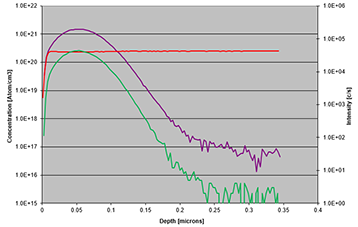Secondary Ion Mass Spectrometry (SIMS)

Secondary Mass Ion Spectrometry (SIMS) is a powerful analytical technique sensitive to most elements, with the ability to detect dopant or impurity species at concentrations as low as parts per billion (ppb). SIMS uses a focussed primary ion beam to sputter/etch material from a sample. The sputtered material may be ionised by the process and is extracted to form a secondary ion beam which is then focussed and mass analysed. Through the use of appropriate reference samples, it is possible to quantify this data.
The use of an ion beam to remove material from a sample for analysis is present in a number of analytical methods. With SIMS, the ion beam is typically O2+ or Cs+ depending on the sample and analysis required. This ion beam impacts the surface of the sample and produces, via sputtering, charged sample ions which are ejected from the sample. These secondary ions are collected and mass analysed to produce depth profile data. As a result, it is possible to analyse species of interest with respect to layer thickness. The impact energy of the primary ions with respect to the sample makes profiling at the micron level possible at the expense of chemical information.
